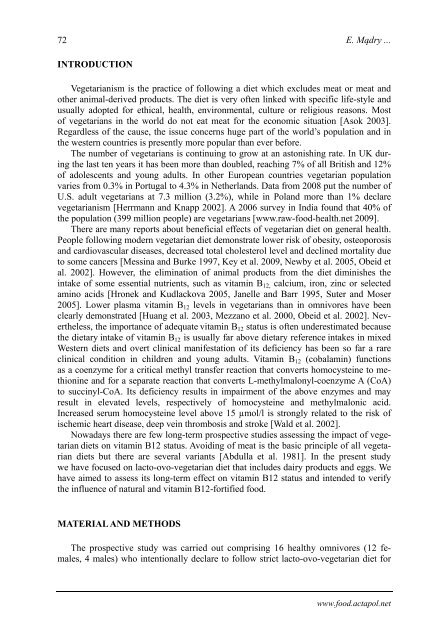Effect of lacto-ovo-vegetarian diet on serum vitamin - Technologia ...
Effect of lacto-ovo-vegetarian diet on serum vitamin - Technologia ... Effect of lacto-ovo-vegetarian diet on serum vitamin - Technologia ...
72 INTRODUCTION E. Mądry ... Vegetarianism is the practice
- Page 1: ACTA Acta Sci. Pol., Technol. Alime
- Page 5 and 6: Effect of<
72<br />
INTRODUCTION<br />
E. Mądry ...<br />
Vegetarianism is the practice <str<strong>on</strong>g>of</str<strong>on</strong>g> following a <str<strong>on</strong>g>diet</str<strong>on</strong>g> which excludes meat or meat and<br />
other animal-derived products. The <str<strong>on</strong>g>diet</str<strong>on</strong>g> is very <str<strong>on</strong>g>of</str<strong>on</strong>g>ten linked with specific life-style and<br />
usually adopted for ethical, health, envir<strong>on</strong>mental, culture or religious reas<strong>on</strong>s. Most<br />
<str<strong>on</strong>g>of</str<strong>on</strong>g> <str<strong>on</strong>g>vegetarian</str<strong>on</strong>g>s in the world do not eat meat for the ec<strong>on</strong>omic situati<strong>on</strong> [Asok 2003].<br />
Regardless <str<strong>on</strong>g>of</str<strong>on</strong>g> the cause, the issue c<strong>on</strong>cerns huge part <str<strong>on</strong>g>of</str<strong>on</strong>g> the world’s populati<strong>on</strong> and in<br />
the western countries is presently more popular than ever before.<br />
The number <str<strong>on</strong>g>of</str<strong>on</strong>g> <str<strong>on</strong>g>vegetarian</str<strong>on</strong>g>s is c<strong>on</strong>tinuing to grow at an ast<strong>on</strong>ishing rate. In UK during<br />
the last ten years it has been more than doubled, reaching 7% <str<strong>on</strong>g>of</str<strong>on</strong>g> all British and 12%<br />
<str<strong>on</strong>g>of</str<strong>on</strong>g> adolescents and young adults. In other European countries <str<strong>on</strong>g>vegetarian</str<strong>on</strong>g> populati<strong>on</strong><br />
varies from 0.3% in Portugal to 4.3% in Netherlands. Data from 2008 put the number <str<strong>on</strong>g>of</str<strong>on</strong>g><br />
U.S. adult <str<strong>on</strong>g>vegetarian</str<strong>on</strong>g>s at 7.3 milli<strong>on</strong> (3.2%), while in Poland more than 1% declare<br />
<str<strong>on</strong>g>vegetarian</str<strong>on</strong>g>ism [Herrmann and Knapp 2002]. A 2006 survey in India found that 40% <str<strong>on</strong>g>of</str<strong>on</strong>g><br />
the populati<strong>on</strong> (399 milli<strong>on</strong> people) are <str<strong>on</strong>g>vegetarian</str<strong>on</strong>g>s [www.raw-food-health.net 2009].<br />
There are many reports about beneficial effects <str<strong>on</strong>g>of</str<strong>on</strong>g> <str<strong>on</strong>g>vegetarian</str<strong>on</strong>g> <str<strong>on</strong>g>diet</str<strong>on</strong>g> <strong>on</strong> general health.<br />
People following modern <str<strong>on</strong>g>vegetarian</str<strong>on</strong>g> <str<strong>on</strong>g>diet</str<strong>on</strong>g> dem<strong>on</strong>strate lower risk <str<strong>on</strong>g>of</str<strong>on</strong>g> obesity, osteoporosis<br />
and cardiovascular diseases, decreased total cholesterol level and declined mortality due<br />
to some cancers [Messina and Burke 1997, Key et al. 2009, Newby et al. 2005, Obeid et<br />
al. 2002]. However, the eliminati<strong>on</strong> <str<strong>on</strong>g>of</str<strong>on</strong>g> animal products from the <str<strong>on</strong>g>diet</str<strong>on</strong>g> diminishes the<br />
intake <str<strong>on</strong>g>of</str<strong>on</strong>g> some essential nutrients, such as <strong>vitamin</strong> B12, calcium, ir<strong>on</strong>, zinc or selected<br />
amino acids [Hr<strong>on</strong>ek and Kudlackova 2005, Janelle and Barr 1995, Suter and Moser<br />
2005]. Lower plasma <strong>vitamin</strong> B12 levels in <str<strong>on</strong>g>vegetarian</str<strong>on</strong>g>s than in omnivores have been<br />
clearly dem<strong>on</strong>strated [Huang et al. 2003, Mezzano et al. 2000, Obeid et al. 2002]. Nevertheless,<br />
the importance <str<strong>on</strong>g>of</str<strong>on</strong>g> adequate <strong>vitamin</strong> B12 status is <str<strong>on</strong>g>of</str<strong>on</strong>g>ten underestimated because<br />
the <str<strong>on</strong>g>diet</str<strong>on</strong>g>ary intake <str<strong>on</strong>g>of</str<strong>on</strong>g> <strong>vitamin</strong> B12 is usually far above <str<strong>on</strong>g>diet</str<strong>on</strong>g>ary reference intakes in mixed<br />
Western <str<strong>on</strong>g>diet</str<strong>on</strong>g>s and overt clinical manifestati<strong>on</strong> <str<strong>on</strong>g>of</str<strong>on</strong>g> its deficiency has been so far a rare<br />
clinical c<strong>on</strong>diti<strong>on</strong> in children and young adults. Vitamin B12 (cobalamin) functi<strong>on</strong>s<br />
as a coenzyme for a critical methyl transfer reacti<strong>on</strong> that c<strong>on</strong>verts homocysteine to methi<strong>on</strong>ine<br />
and for a separate reacti<strong>on</strong> that c<strong>on</strong>verts L-methylmal<strong>on</strong>yl-coenzyme A (CoA)<br />
to succinyl-CoA. Its deficiency results in impairment <str<strong>on</strong>g>of</str<strong>on</strong>g> the above enzymes and may<br />
result in elevated levels, respectively <str<strong>on</strong>g>of</str<strong>on</strong>g> homocysteine and methylmal<strong>on</strong>ic acid.<br />
Increased <strong>serum</strong> homocysteine level above 15 µmol/l is str<strong>on</strong>gly related to the risk <str<strong>on</strong>g>of</str<strong>on</strong>g><br />
ischemic heart disease, deep vein thrombosis and stroke [Wald et al. 2002].<br />
Nowadays there are few l<strong>on</strong>g-term prospective studies assessing the impact <str<strong>on</strong>g>of</str<strong>on</strong>g> <str<strong>on</strong>g>vegetarian</str<strong>on</strong>g><br />
<str<strong>on</strong>g>diet</str<strong>on</strong>g>s <strong>on</strong> <strong>vitamin</strong> B12 status. Avoiding <str<strong>on</strong>g>of</str<strong>on</strong>g> meat is the basic principle <str<strong>on</strong>g>of</str<strong>on</strong>g> all <str<strong>on</strong>g>vegetarian</str<strong>on</strong>g><br />
<str<strong>on</strong>g>diet</str<strong>on</strong>g>s but there are several variants [Abdulla et al. 1981]. In the present study<br />
we have focused <strong>on</strong> <str<strong>on</strong>g>lacto</str<strong>on</strong>g>-<str<strong>on</strong>g>ovo</str<strong>on</strong>g>-<str<strong>on</strong>g>vegetarian</str<strong>on</strong>g> <str<strong>on</strong>g>diet</str<strong>on</strong>g> that includes dairy products and eggs. We<br />
have aimed to assess its l<strong>on</strong>g-term effect <strong>on</strong> <strong>vitamin</strong> B12 status and intended to verify<br />
the influence <str<strong>on</strong>g>of</str<strong>on</strong>g> natural and <strong>vitamin</strong> B12-fortified food.<br />
MATERIAL AND METHODS<br />
The prospective study was carried out comprising 16 healthy omnivores (12 females,<br />
4 males) who intenti<strong>on</strong>ally declare to follow strict <str<strong>on</strong>g>lacto</str<strong>on</strong>g>-<str<strong>on</strong>g>ovo</str<strong>on</strong>g>-<str<strong>on</strong>g>vegetarian</str<strong>on</strong>g> <str<strong>on</strong>g>diet</str<strong>on</strong>g> for<br />
www.food.actapol.net



